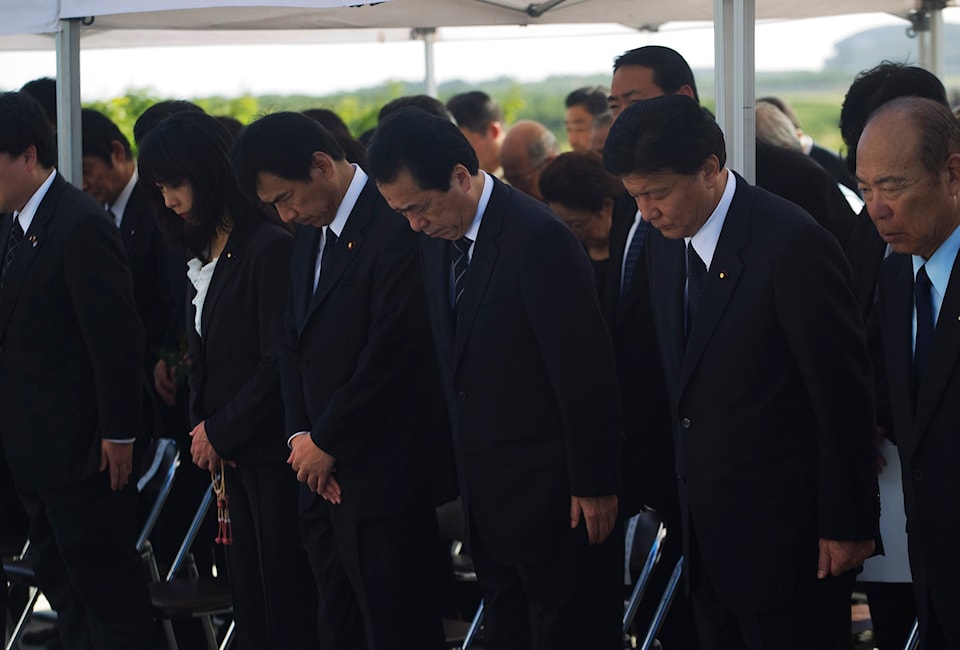IOTO, Japan — In a rare visit to Iwo Jima, Japan’s prime minister offered prayers Tuesday at two recently discovered mass graves and vowed to find the more than 12,000 fallen soldiers whose bodies have yet to be recovered from the remote island where some of the Second World War’s fiercest fighting took place.
Kneeling in a deep pit with dozens of remains spread out before him, Naoto Kan clasped his hands in prayer and then helped searchers exhume a badly decayed set of bones swathed in a faded green body bag. Workers said it was one of more than 20 found Tuesday alone.
“We will examine every grain of sand,” Kan said. “It is hard to imagine from the beauty of the island today what happened here 65 years ago.”
Kan said he had wanted to visit the island since the discovery in August of the mass graves.
Now known in Japan as Ioto — that was what the island was called by residents before the war — Iwo Jima was the site of one of the most fateful and iconic battles in the Pacific and helped turn the tide against the Japanese.
For many Americans, an Associated Press photo of U.S. marines and a navy corpsman raising the flag atop Mount Suribachi has become one of the most lasting symbols of the war, and of American sacrifice and bravery. More medals of honour — 27, including nearly a third of all given to marines during the Second World War — were awarded for valour on Iwo Jima than any other single campaign.
In Japan, however, Iwo Jima is seen by most as just one of many bloody defeats.
It has been generally ignored since the war, has been left largely untouched and is now uninhabited except for a few hundred troops at a small Japanese military outpost. Kan is only the second prime minister to visit the island. Junichiro Koizumi was the first, five years ago.
But Kan’s government, inspired in part by the success in Japan of the 2006 Clint Eastwood movie “Letters from Iwo Jima” and concerned that time is running out, has made a strong effort to bring closure on Iwo Jima by stepping up the civilian-run mission to recover all of the Japanese dead.
That project began in July and took a big step forward in October, when two mass graves that may hold the remains of more than 2,000 Japanese soldiers were discovered by search teams.
Working off of documents provided by the U.S. National Archives and Records Administration, the Japanese teams found sites listed as “enemy cemeteries” near a runway at the military outpost and at the foot of Suribachi.
“Many troops will be returning home now that these mass graves have been found. I prayed they will rest in peace,” said legislator Yoshitaka Shindo, whose grandfather was commanding officer of Japanese troops on Iwo Jima. “But Ioto’s battle is not over until all of the bodies are recovered.”
Yukihiko Akutsu, a special adviser to the prime minister who heads the search mission, told The Associated Press the main site is estimated to have about 2,000 bodies. Digging was completed this week at the Suribachi site, with 152 remains found. The full excavation effort was expected to take several more months, but Akutsu said the teams have already found more than 300 remains in the two areas.
Akutsu said the government would notify Washington if any American remains are exhumed.
The discovery of the mass graves is one of the biggest breakthroughs in decades toward recovering Iwo Jima’s dead.
“This is a very significant mission,” Akutsu said. “Because we lost the war, for a long time there was not much enthusiasm about projects like this, but time is running out. The families of the dead, their brothers and sisters, are in their 80s. We would like to settle this issue in the next three years.”
Iwo Jima’s Japanese defenders were so deeply dug into caves, bunkers and tunnels, and the shelling of the island by the Americans was so intense, that recovering their bodies has been an almost impossible mission despite small-scale annual searches since the 1950s.
Identification of the remains is another difficult hurdle. Few Japanese soldiers wore dog tags or other identification, and their remains have by now deteriorated badly. Unidentified remains are sent to a tomb in Tokyo for unknown soldiers.
“Many of the remains were little more than grains of sand,” said Kazuo Takenoshita, who supervised the dig at the smaller grave site. “They were often piled two to three deep. One soldier’s head would be resting on another’s feet.”
Virtually all the 22,000 Japanese soldiers tasked with defending the rugged crag were killed in the battle, which claimed 6,821 American and 21,570 Japanese lives. Dozens of remains are recovered every year, but about 12,000 Japanese are still classified as missing in action and presumed killed on the island, along with 218 Americans.
The island, 1,100 kilometres south of Tokyo, was seen as key to the United States because it had an early warning radar station and three airfields used by Japanese fighter planes that posed a threat to U.S. bombing raids on Tokyo and Japan’s main islands.
The U.S. wanted the airfields for its fighter escort planes.
Fighting began Feb. 19, 1945, but Iwo Jima was not declared secured until March 26. Japan surrendered in August of that year, after the atomic bombings of Hiroshima and Nagasaki.
